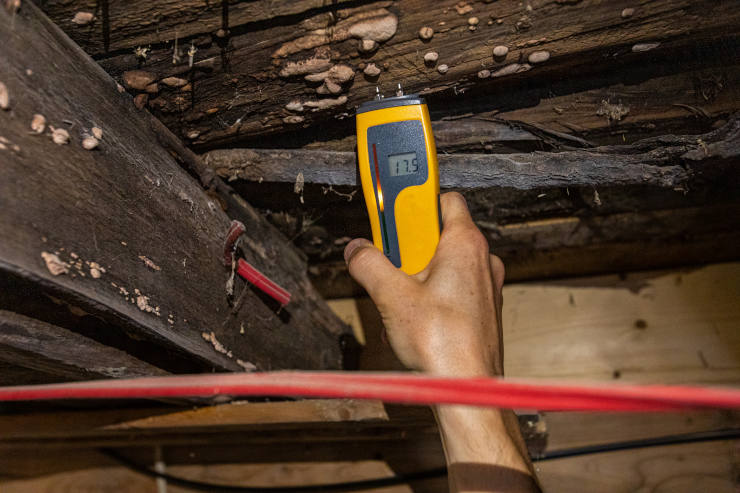
Timber is a structural building material routinely found in properties old and new. Whether you are thinking of buying a modern home or a period cottage, the structural integrity of the building largely depends on the timber elements being sound.
Structural roof members, floor joists, window frames and other timber elements can decay under adverse environmental conditions such as damp and wetness, and problems can manifest as wood rot and insect infestations that can range from relatively harmless to potentially serious.
This where Hammond & Shaw can help. As a long-standing firm of Chartered Surveyors in South Devon, we specialise in conducting full Building Surveys, HomeBuyer Surveys and Mortgage Valuations for all types of property across the area. Our directors have many years’ experience surveying residential property, with a reputation for quality, service and a professional approach that is second to none.
If your property survey has flagged up timber decay, it’s important to understand what this actually means. Armed with all the relevant facts, you can then decide whether and how to proceed with the purchase and how to tackle the problem at hand.
Biological attack on building timbers can take many forms. There are various living organisms that use timber as food, and the best known and potentially destructive types of timber decay are caused by Dry Rot, Wet Rot, Death Watch Beetle, Common Furniture Beetle and Powder-Post Beetle.
What is Dry Rot?
Dry Rot is actually caused by a fungus (Serpula lacrymans) that can lie dormant in wood until the right conditions present themselves for the fungus to thrive. These include a relative humidity of 95% and a timber moisture content of more than 20%. Mature Dry Rot has a distinctive orange coloured, plate-shaped fruiting body, with greyish threads (mycelium) that help the fungus to spread across timber and other building materials including brickwork. Timber that has been damaged by Dry Rot is easily recognised by its light brown colour, dry and brittle texture, and cuboidal cracking.
Dry Rot is an aggressive form of decay that can spread and destroy softwood and hardwood timber, causing serious structural problems. Urgent action is always highly recommended.
How is Wet Rot different?
The main culprit for timber decay in buildings is Wet Rot. Wet Rot or cellar fungus (Coniophora puteana) either leads to timber becoming darker (brown rot) or lighter (white rot). This fungus thrives in persistently damp conditions that have a moisture content of 50-60%. Wet Rot usually manifests as black or brown strands, but cuboidal cracking and fruiting bodies similar to Dry Rot may also be present.
Wet Rot fungus tends to stay more localised, usually mainly affecting timber at the source of the damp. That’s not to say it isn’t a serious concern. Left untreated, Wet rot can cause major structural problems.
How serious is a Death Watch Beetle attack?
The Death Watch Beetle (Xestobium rufovillosum) gets its name from the distinctive tapping or ticking sound it makes during the mating season, which is most audible at night. Ancient lore has it that this sound is an omen of tragedy to come. For a Death Watch Beetle infestation to become established, damp conditions must already be present. Older buildings are more at risk and large hardwood (typically oak or elm) timbers that are already affected by timber decay are the most likely sites for attack. Beetles are most active in spring when they emerge through 3mm-bore holes and leave behind coarse bore dust.
The damage caused can take the form of extensive tunnelling within the property’s timbers, weakening the integrity of the wood. It goes without saying that urgent professional attention should be sought.
Are there any other beetles to worry about?
Woodworm is the general term used for the Common Furniture Beetle (Anobium punctatum) who likes to attack the sapwood of softwoods and hardwoods. Most active during the warmer season, its presence can be detected by tiny 1-2mm bore holes and cream-coloured bore dust, typically found in poorly ventilated roof voids or damp areas under suspended timber flooring.
Finally, the Powder-Post Beetle (Lyctus brunneus) deserves a mention. It mainly attacks the sapwood of hardwoods such as oak, elm, ash and chestnut, though not softwoods. This wood-boring insect is active all year round, preferring centrally heated buildings. Tell-tale signs of an infestation include 1.5mm-wide boreholes and powder-fine bore dust.
What to do next?
If you know or suspect that damp may be an issue in the building you are thinking of investing in, or you suspect fungal decay, it is essential to carry out a full professional inspection to find out where the water is coming from and how extensive the timber damage is.
Whether you are buying a period property or a post-war home, Hammond & Shaw are at your service with a choice of home surveys to help you discover the full facts about the condition of the building in question. It should go without saying that any property affected by timber decay can be a serious liability, potentially requiring extensive and costly remedial works. At H&S Chartered Surveyors, we have many years’ experience in providing specialist advice and guidance to property buyers in Exeter, Torquay, the South Hams and beyond and look forward to being of service. Contact us today.